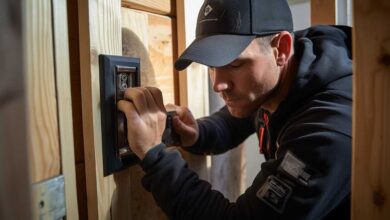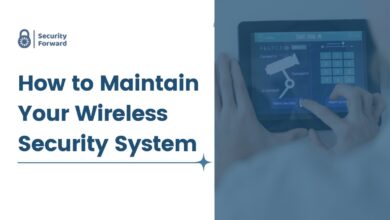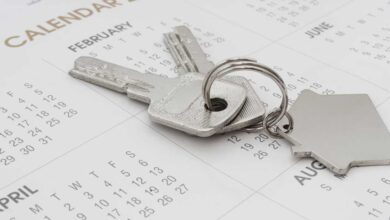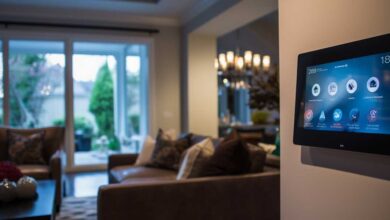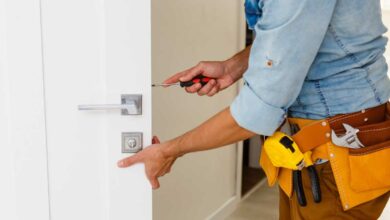Cost And Time Estimates For Home Security System Installation
Investing in a home security system is crucial to ensuring the safety and security of your property and loved ones. However, understanding the cost and time estimates for installing such systems can often take time and effort.
This article aims to provide a comprehensive guide on the cost and time estimates for home security system installation, breaking down the various factors that contribute to these estimates. Whether you’re a homeowner looking to secure your property or a business owner offering security system services, this guide will provide valuable insights to help you make informed decisions.
Cost Estimates for Home Security System Installation
Navigating the world of home security systems can be a complex task. To make this journey smoother, we’ve crafted a detailed guide to help you understand the financial aspects of installing a home security system.
This section will explore the various types of home security systems, their associated equipment and installation costs, and the operational expenses for monitored and unmonitored systems.
This knowledge will empower you to make a well-informed decision about your home’s most suitable security solution. Let’s dive into the financial elements of home security system installation.
Types of Home Security Systems and Their Cost
The market is flooded with an array of home security systems, each boasting unique features, levels of complexity, and price tags. Here’s a snapshot of some commonly used types and their estimated costs:
-
Wireless Home Security Systems: Known for their adaptability, they can be installed and moved easily. A basic equipment package for these systems typically costs between $200 and $500.
-
Wired Home Security Systems: These systems are hard-wired into your home’s electrical system, offering a reliable yet less flexible solution. Due to the extensive installation process, their cost can range from $500 to $2,000, depending on the system’s complexity.
-
Monitored Home Security Systems: These systems are linked to a remote monitoring service that monitors your property. In addition to the initial setup cost of $500 to $1,500, these services usually charge a monthly fee between $15 and $65.
-
Unmonitored Home Security Systems: These systems rely on you or your neighbors to report security breaches to the authorities. While there are minimal or no operational costs, the installation cost can range from $200 to $1,000, depending on the system’s complexity.
-
Smart Home Security Systems: These high-tech systems allow you to remotely control and monitor your security setup via your smartphone or other devices. These versatile systems typically cost between $500 and $1,500, not including potential subscription costs.
Remember that these are rough estimates, and actual costs can fluctuate based on factors such as brand, model, and specific features of the security systems. The following section will delve deeper into these costs, focusing on Equipment and Installation Costs.
Equipment and Installation Costs
When considering the total expense of a home security system, it’s essential to factor in both the equipment and installation costs. These can vary greatly, depending on the system’s complexity and the specific needs of your home. Let’s delve into these aspects in more detail.
-
Equipment Costs: Essential devices like cameras, sensors, and alarms constitute the bulk of expenses, with basic kits costing $200-$300 and advanced setups over $1,000.
-
Installation Costs: Costs vary between DIY and professional services, the latter standing at $99-$250, ensuring expert setup and support.
-
Activation Costs: Some providers charge an activation fee post-installation.
Operating Costs: Monitored vs. Unmonitored Systems
Understanding the operational costs of your chosen home security system is equally important as the installation and equipment costs. These costs can differ significantly between monitored and unmonitored systems.
-
Monitored Systems: Monitored systems usually require a monthly or yearly subscription fee, typically $15-$65 per month. This fee covers the cost of professional round-the-clock monitoring services that can promptly alert authorities in case of a break-in. Enhanced services, such as medical or fire alarm monitoring, may incur additional charges. Some companies offer equipment discounts if you commit to a long-term monitoring contract.
-
Unmonitored Systems: Unmonitored systems rely on you or your neighbors to report security incidents. While these systems generally do not have ongoing fees, you might not be immediately aware of a security breach, particularly if you’re away from home. Interactive services that enable self-monitoring through smartphone alerts may come with a nominal monthly fee, often under $10.
Therefore, when deciding between a monitored or unmonitored system, consider the initial costs, the recurring expenses, and the level of security you require. With this understanding, let’s discuss the time considerations for home security installations.
Time Estimates for Home Security System Installation
When contemplating installing a home security system, factoring in the time commitment involved is essential. From the initial planning stage to a fully functional system, the process requires careful scheduling and patience.
In the subsequent sections, we’ll break down the time allocation for each process phase, including the preliminary planning, actual installation, and ongoing maintenance and upgrades.
Planning and Pre-Installation
The journey towards a secure home begins with meticulous planning and pre-installation procedures. This preliminary phase, which can span from a few days to several weeks, comprises several crucial steps.
1. Home Assessment: This initial step comprehensively evaluates your home’s infrastructure and potential security vulnerabilities. A security professional will work with you to pinpoint the optimal locations for installing security equipment. Depending on your home’s size and layout, this step could take a few hours.
2. System Selection: Post-assessment, you’ll be tasked with choosing a security system that aligns with your requirements and financial plan. Factors to consider include the monitoring and alert system, control panel features, and the quantity and variety of sensors and cameras. This decision-making process could span a few days to a week as you weigh your options and solicit quotes for different systems.
3. Equipment Purchase: After settling on a system, the subsequent step is to procure the necessary equipment. The duration of this step can fluctuate, especially if you opt for customized components that may not be immediately available. Generally, if the equipment isn’t available in-store, you might have to wait a few days to several weeks for delivery.
Overall, the time required for planning and pre-installation largely depends on your chosen system’s complexity and the supplier’s availability. A thorough understanding of these steps can enhance the project’s success and ensure your security system is tailored to your needs and offers maximum protection.
Installation Timeline
The journey to a secure home begins with installing your chosen security system. The duration of this process is influenced by many factors, including the system’s complexity, the intricacy of the installation, and the dimensions of your home.
-
Basic Systems: If you’ve opted for a straightforward security system comprising a handful of sensors and a single camera, professional installation could be wrapped up in hours. If you’re technically inclined, you might even consider a DIY installation.
-
Intermediate Systems: A security system with multiple sensors, cameras, and additional features such as smoke alarms or home automation capabilities could require a full day’s work for professional installers. If you’re planning a DIY installation, be prepared for it to stretch over a longer period, depending on your technical prowess and availability.
-
Advanced Systems: Security systems that incorporate a wide array of high-tech sensors, multiple cameras, and integration with other home systems, such as HVAC or lighting controls, may necessitate a few days for professional installation.
Given the variability in installation timelines, it’s crucial to have a detailed discussion with your security provider or contractor to ensure they allocate adequate time for a thorough and secure setup.
Maintenance and Upgrades Time Investment
Effective home security demands regular maintenance and occasional upgrades, with the time commitment varying based on your system’s complexity.
-
Periodic Maintenance: Routine checks, battery replacements, and equipment cleaning, essential every few months, can be self-managed or professionally handled.
-
Software Updates: These necessary enhancements may be automatic or require user action, with time investment depending on the update’s extent.
-
Hardware Upgrades: Incorporating advanced technology or additional devices necessitates a time commitment similar to the initial setup, contingent on upgrade complexity.
Acknowledging the continual time investment for system upkeep is crucial for optimal home protection.
Factors Influencing Cost and Time of Installation
As you embark on your journey to secure your home, it’s crucial to be aware that the installation process’s cost and duration are subject to various factors. Your home’s size and design significantly impact the cost and timeframe of security system installation, directly affecting equipment needs and installation duration.
-
Home Size: Larger properties need more sensors and cameras, increasing both expenses and installation time.
-
Home Layout: Due to wiring and equipment placement challenges, complex architectures with multiple floors extend the installation process.
For extensive or intricate homes, expect higher installation costs and longer timelines than smaller, simpler structures.
Consideration of Local Regulations and Permits
It’s crucial to recognize local regulations and permits’ role in installing a home security system. These factors can significantly impact the overall cost and timeline of your project. For instance, certain areas may necessitate permits for hard-wired systems or those equipped with external sirens or lighting.
-
Regulatory Compliance: Different regions have specific rules regarding the types of security systems permitted, particularly those with external visual or audio alerts. Failing to adhere to these regulations can result in fines and require system modifications post-installation, escalating costs, and extending timelines.
-
Permit Acquisition: Securing the necessary permits can be both time-consuming and costly. The requirements can vary widely, so conducting thorough research or seeking advice from a local professional is prudent.
Being well-informed about local regulations and permit requirements can help you avoid unforeseen expenses and delays during your home security system installation.
